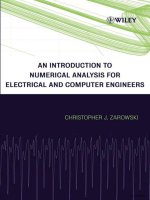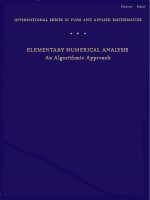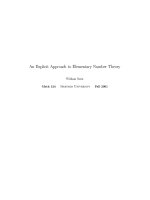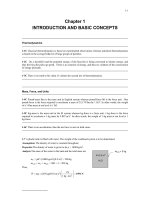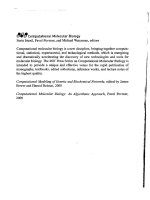elementary numerical analysis an algorithmic approach, 3rd ed - de boor
Bạn đang xem bản rút gọn của tài liệu. Xem và tải ngay bản đầy đủ của tài liệu tại đây (5.34 MB, 445 trang )
Next
Home
ELEMENTARY NUMERICAL ANALYSIS
An Algorithmic Approach
International Series in Pure and Applied Mathematics
G. Springer
Consulting Editor
Ahlfors: Complex Analysis
Bender and Orszag: Advanced Mathematical Methods for Scientists and Engineers
Buck: Advanced Calculus
Busacker and Saaty: Finite Graphs and Networks
Cheney: Introduction to Approximation Theory
Chester: Techniques in Partial Differential Equations
Coddington and Levinson: Theory of Ordinary Differential Equations
Conte and de Boor: Elementary Numerical Analysis: An Algorithmic Approach
Dennemeyer: Introduction to Partial Differential Equations and Boundary Value
Problems
Dettman: Mathematical Methods in Physics and Engineering
Hamming: Numerical Methods for Scientists and Engineers
Hildebrand: Introduction to Numerical Analysis
Householder: The Numerical Treatment of a Single Nonlinear Equation
Kalman, Falb, and Arbib: Topics in Mathematical Systems Theory
McCarty: Topology: An Introduction with Applications to Topological Groups
Moore: Elements of Linear Algebra and Matrix Theory
Moursund and Duris: Elementary Theory and Application of Numerical Analysis
Pipes and Harvill: Applied Mathematics for Engineers and Physicists
Ralston and Rabinowitz: A First Course in Numerical Analysis
Ritger and Rose: Differential Equations with Applications
Rudin: Principles of Mathematical Analysis
Shapiro: Introduction to Abstract Algebra
Simmons: Differential Equations with Applications and Historical Notes
Simmons: Introduction to Topology and Modern Analysis
Struble: Nonlinear Differential Equations
ELEMENTARY
NUMERICAL
ANALYSIS
An Algorithmic Approach
Third Edition
S. D. Conte
Purdue University
Carl de Boor
Universiry of Wisconsin—Madison
McGraw-Hill Book Company
New York St. Louis San Francisco Auckland Bogotá Hamburg
Johannesburg London Madrid Mexico Montreal New Delhi
Panama Paris São Paulo Singapore Sydney Tokyo Toronto
ELEMENTARY NUMERICAL ANALYSIS
An Algorithmic Approach
Copyright © 1980, 1972, 1965 by McGraw-Hill, inc. All rights reserved.
Printed in the United States of America. No part of this publication
may be reproduced, stored in a retrieval system, or transmitted, in any
form or by any means, electronic, mechanical, photocopying, recording or
otherwise, without the prior written permission of the publisher.
234567890 DODO 89876543210
This book was set in Times Roman by Science Typographers, Inc. The
editors were Carol Napier and James S. Amar; the production supervisor
was Phil Galea. The drawings were done by Fine Line Illustrations, Inc.
R. R. Donnelley & Sons Company was printer and binder.
Library of Congress Cataloging in Publication Data
Conte, Samuel Daniel, date
Elementary numerical analysis.
(International series in pure and applied
mathematics)
Includes index.
1. Numerical analysis-Data processing.
I.de Boor, Carl, joint author. II. Title.
QA297.C65
1980
519.4 79-24641
ISBN 0-07-012447-7
CONTENTS
Chapter 1
1.1
1.2
1.3
1.4
1
1
4
7
1.5
1.6
1.7
Chapter 2
2.1
2.2
2.3
*2.4
2.5
2.6
*2.7
Preface
Introduction
Number Systems and Errors
The Representation of Integers
The Representation of Fractions
Floating-Point Arithmetic
Loss of Significance and Error Propagation;
Condition and Instability
Computational Methods for Error Estimation
Some Comments on Convergence of Sequences
Some Mathematical Preliminaries
Interpolation by Polynomial
Polynomial Forms
Existence and Uniqueness of the Interpolating Polynomial
The Divided-Difference Table
Interpolation at an Increasing Number of
Interpolation Points
The Error of the Interpolating Polynomial
Interpolation in a Function Table Based on Equally
Spaced Points
The Divided Difference as a Function of Its Arguments
and Osculatory Interpolation
* Sections marked with an asterisk may be omitted without loss of continuity.
ix
xi
12
18
19
25
31
31
38
41
46
51
55
62
V
vi CONTETS
Chapter 3 The Solution of Nonlinear Equations
72
3.1
A Survey of Iterative Methods
74
3.2
Fortran Programs for Some Iterative Methods
81
3.3
Fixed-Point Iteration
88
3.4
Convergence Acceleration for Fixed-Point Iteration
95
*3.5
Convergence of the Newton and Secant Methods
100
3.6
Polynomial Equations: Real Roots
110
*3.7
Complex Roots and Müller’s Method
120
Chapter 4
Matrices and Systems of Linear Equations
4.1
Properties of Matrices
4.2
The Solution of Linear Systems by Elimination
4.3
The Pivoting Strategy
4.4
The Triangular Factorization
4.5
Error and Residual of an Approximate Solution; Norms
4.6
Backward-Error Analysis and Iterative Improvement
*4.7
Determinants
*4.8
The Eigenvalue Problem
Chapter *5 Systems of Equations and Unconstrained
Optimization
*5.1
Optimization and Steepest Descent
*5.2
Newton’s Method
*5.3
Fixed-Point Iteration and Relaxation Methods
Chapter 6 Approximation
6.1
Uniform Approximation by Polynomials
6.2
Data Fitting
*6.3
Orthogonal Polynomials
*6.4
Least-Squares Approximation by Polynomials
*6.5
Approximation by Trigonometric Polynomials
*6.6
Fast Fourier Transforms
6.7
Piecewise-Polynomial Approximation
Chapter 7
7.1
7.2
7.3
7.4
7.5
l 7.6
l 7.7
Differentiation and Integration
Numerical Differentiation
Numerical Integration: Some Basic Rules
Numerical Integration: Gaussian Rules
Numerical Integration: Composite Rules
Adaptive Quadrature
Extrapolation to the Limit
Romberg Integration
128
128
147
157
160
169
177
185
189
208
209
216
223
235
235
245
251
259
268
277
284
294
295
303
311
319
328
333
340
CONTENTS vii
Chapter 8
8.1
8.2
8.3
8.4
8.5
8.6
8.7
8.8
8.9
*8.10
*8.11
*8.12
*8.13
Mathematical Preliminaries
Simple Difference Equations
The Solution of Differential Equations
Numerical Integration by Taylor Series
Error Estimates and Convergence of Euler’s Method
Runge-Kutta Methods
Step-Size Control with Runge-Kutta Methods
Multistep Formulas
Predictor-Corrector Methods
The Adams-Moulton Method
Stability of Numerical Methods
Round-off-Error Propagation and Control
Systems of Differential Equations
Stiff Differential Equations
Chapter 9 Boundary Value Problems
9.1
Finite Difference Methods
9.2
Shooting Methods
9.3
Collocation Methods
Appendix: Subroutine Libraries
421
References
423
Index
425
346
346
349
354
359
362
366
373
379
382
389
395
398
401
406
406
412
416
PREFACE
This is the third edition of a book on elementary numerical analysis which
is designed specifically for the needs of upper-division undergraduate
students in engineering, mathematics, and science including, in particular,
computer science. On the whole, the student who has had a solid college
calculus sequence should have no difficulty following the material.
Advanced mathematical concepts, such as norms and orthogonality, when
they are used, are introduced carefully at a level suitable for undergraduate
students and do not assume any previous knowledge. Some familiarity
with matrices is assumed for the chapter on systems of equations and with
differential equations for Chapters 8 and 9. This edition does contain some
sections which require slightly more mathematical maturity than the previ-
ous edition. However, all such sections are marked with asterisks and all
can be omitted by the instructor with no loss in continuity.
This new edition contains a great deal of new material and significant
changes to some of the older material. The chapters have been rearranged
in what we believe is a more natural order. Polynomial interpolation
(Chapter 2) now precedes even the chapter on the solution of nonlinear
systems (Chapter 3) and is used subsequently for some of the material in
all chapters. The treatment of Gauss elimination (Chapter 4) has been
simplified. In addition, Chapter 4 now makes extensive use of Wilkinson’s
backward error analysis, and contains a survey of many well-known
methods for the eigenvalue-eigenvector problem. Chapter 5 is a new
chapter on systems of equations and unconstrained optimization. It con-
tains an introduction to steepest-descent methods, Newton’s method for
nonlinear systems of equations, and relaxation methods for solving large
linear systems by iteration. The chapter on approximation (Chapter 6) has
been enlarged. It now treats best approximation and good approximation
ix
x PREFACE
by polynomials, also approximation by trigonometric functions, including
the Fast Fourier Transforms, as well as least-squares data fitting, orthogo-
nal polynomials, and curve fitting by splines. Differentiation and integra-
tion are now treated in Chapter 7, which contains a new section on
adaptive quadrature. Chapter 8 on ordinary differential equations contains
considerable new material and some new sections. There is a new section
on step-size control in Runge-Kutta methods and a new section on stiff
differential equations as well as an extensively revised section on numerical
instability. Chapter 9 contains a brief introduction to collocation as a
method for solving boundary-value problems.
This edition, as did the previous one, assumes that students have
access to a computer and that they are familiar with programming in some
procedure-oriented language. A large number of algorithms are presented
in the text, and FORTRAN programs for many of these algorithms have
been provided. There are somewhat fewer complete programs in this
edition. All the programs have been rewritten in the FORTRAN 77
language which uses modern structured-programming concepts. All the
programs have been tested on one or more computers, and in most cases
machine results are presented. When numerical output is given, the text
will indicate which machine (IBM, CDC, UNIVAC) was used to obtain
the results.
The book contains more material than can usually be covered in a
typical one-semester undergraduate course for general science majors. This
gives the instructor considerable leeway in designing the course. For this, it
is important to point out that only the material on polynomial interpola-
tion in Chapter 2, on linear systems in Chapter 4, and on differentiation
and integration in Chapter 7, is required in an essential way in subsequent
chapters. The material in the first seven chapters (exclusive of the starred
sections) would make a reasonable first course.
We take this opportunity to thank those who have communicated to us
misprints and errors in the second edition and have made suggestions for
improvement. We are especially grateful to R. E. Barnhill, D. Chambless,
A. E. Davidoff, P. G. Davis, A. G. Deacon, A. Feldstein, W. Ferguson,
A. O. Garder, J. Guest, T. R. Hopkins, D. Joyce, K. Kincaid, J. T. King,
N. Krikorian, and W. E. McBride.
S. D. Conte
Carl de Boor
INTRODUCTION
This book is concerned with the practical solution of problems on com-
puters. In the process of problem solving, it is possible to distinguish
several more or less distinct phases. The first phase is formulation. In
formulating a mathematical model of a physical situation, scientists should
take into account beforehand the fact that they expect to solve a problem
on a computer. They will therefore provide for specific objectives, proper
input data, adequate checks, and for the type and amount of output.
Once a problem has been formulated, numerical methods, together
with a preliminary error analysis, must be devised for solving the problem.
A numerical method which can be used to solve a problem will be called
an algorithm. An algorithm is a complete and unambiguous set of proce-
dures leading to the solution of a mathematical problem. The selection or
construction of appropriate algorithms properly falls within the scope of
numerical analysis. Having decided on a specific algorithm or set of
algorithms for solving the problem, numerical analysts should consider all
the sources of error that may affect the results. They must consider how
much accuracy is required, estimate the magnitude of the round-off and
discretization errors, determine an appropriate step size or the number of
iterations required, provide for adequate checks on the accuracy, and make
allowance for corrective action in cases of nonconvergence.
The third phase of problem solving is programming. The programmer
must transform the suggested algorithm into a set of unambiguous step-
by-step instructions to the computer. The first step in this procedure is
called flow charting. A flow chart is simply a set of procedures, usually in
logical block form, which the computer will follow. It may be given in
graphical or procedural statement form. The complexity of the flow will
depend upon the complexity of the problem and the amount of detail
xi
xii INTRODUCTION
included. However, it should be possible for someone other than the
programmer to follow the flow of information from the chart. The flow
chart is an effective aid to the programmer, who must translate its major
functions into a program, and, at the same time, it is an effective means of
communication to others who wish to understand what the program does.
In this book we sometimes use flow charts in graphical form, but more
often in procedural statement form. When graphical flow charts are used,
standard conventions are followed, whereas all procedural statement charts
use a self-explanatory ALGOL-like statement language. Having produced
a flow chart, the programmer must transform the indicated procedures into
a set of machine instructions. This may be done directly in machine
language, in an assembly language, or in a procedure-oriented language. In
this book a dialect of FORTRAN called FORTRAN 77 is used exclu-
sively. FORTRAN 77 is a new dialect of FORTRAN which incorporates
new control statements and which emphasizes modern structured-program-
ming concepts. While FORTRAN IV compilers are available on almost all
computers, FORTRAN 77 may not be as readily available. However,
conversion from FORTRAN 77 to FORTRAN IV should be relatively
straightforward.
A procedure-oriented language such as FORTRAN or ALGOL is
sometimes called an algorithmic language. It allows us to express a
mathematical algorithm in a form more suitable for communication with
computers. A FORTRAN procedure that implements a mathematical
algorithm will, in general, be much more precise than the mathematical
algorithm. If, for example, the mathematical algorithm specifies an itera-
tive procedure for finding the solution of an equation, the FORTRAN
program must specify (1) the accuracy that is required, (2) the number of
iterations to be performed, and (3) what to do in case of nonconvergence.
Most of the algorithms in this book are given in the normal mathematical
form and in the more precise form of a FORTRAN procedure.
In many installations, each of these phases of problem solving is
performed by a separate person. In others, a single person may be
responsible for all three functions. It is clear that there are many interac-
tions among these three phases. As the program develops, more informa-
tion becomes available, and this information may suggest changes in the
formulation, in the algorithms being used, and in the program itself.
ELEMENTARY NUMERICAL ANALYSIS
An Algorithmic Approach
CHAPTER
ONE
NUMBER SYSTEMS AND ERRORS
In this chapter we consider methods for representing numbers on com-
puters and the errors introduced by these representations. In addition, we
examine the sources of various types of computational errors and their
subsequent propagation. We also discuss some mathematical preliminaries.
1.1 THE REPRESENTATION OF INTEGERS
In everyday life we use numbers based on the decimal system. Thus the
number 257, for example, is expressible as
257 = 2·100 + 5·10 + 7·1
= 2·10
2
+ 5·10
1
+ 7·100
0
We call 10 the base of this system. Any integer is expressible as a
polynomial in the base 10 with integral coefficients between 0 and 9. We
use the notation
N = (a
n
a
n-1
··· a
0
)
10
= a
n
10
n
+ a
n-1
10
n-1
+ ··· + a
0
10
0
(1.1)
to denote any positive integer in the base 10. There is no intrinsic reason to
use 10 as a base. Other civilizations have used other bases such as 12, 20,
or 60. Modern computers read pulses sent by electrical components. The
state of an electrical impulse is either on or off. It is therefore convenient to
represent numbers in computers in the binary system. Here the base is 2,
and the integer coefficients may take the values 0 or 1.
1
Previous
Home
Next
2 NUMBER SYSTEMS AND ERRORS
A nonnegative integer N will be represented in the binary system as
(1.2)
where the coefficients a
k
are either 0 or 1. Note that N is again represented
as a polynomial, but now in the base 2. Many computers used in scientific
work operate internally in the binary system. Users of computers, however,
prefer to work in the more familiar decimal system. It is therefore neces-
sary to have some means of converting from decimal to binary when
information is submitted to the computer, and from binary to decimal for
output purposes.
Conversion of a binary number to decimal form may be accomplished
directly from the definition (1.2). As examples we have
The conversion of integers from a base to the base 10 can also be
accomplished by the following algorithm, which is derived in Chap. 2.
Algorithm 1.1 Given the coefficients a
n
, . . . , a
0
of the polynomial
(1.3)
and a number Compute recursively the numbers
Then
Since, by the definition (1.2), the binary integer
represents the value of the polynomial (1.3) at x = 2, we can use Algo-
rithm 1.1, with to find the decimal equivalents of binary integers.
Thus the decimal equivalent of (1101)
2
computed using Algorithm 1.1
is
1.1 THE REPRESENTATION OF INTEGERS 3
and the decimal equivalent of (10000)
2
is
Converting a decimal integer N into its binary equivalent can also be
accomplished by Algorithm 1.1 if one is willing to use binary arithmetic.
For if
then by the definition (1.1), N = p(10). where
p(x) is the polynomial (1.3). Hence we can calculate the binary representa-
tion for N by translating the coefficients into binary integers
and then using Algorithm 1.1 to evaluate p(x) at x = 10 = (1010)
2
in
binary arithmetic. If, for example, N = 187, then
and using Algorithm 1.1 and binary arithmetic,
Therefore 187 = (10111011)
2
.
Binary numbers and binary arithmetic, though ideally suited for
today’s computers, are somewhat tiresome for people because of the
number of digits necessary to represent even moderately sized numbers.
Thus eight binary digits are necessary to represent the three-decimal-digit
number 187. The octal number system, using the base 8, presents a kind of
compromise between the computer-preferred binary and the people-pre-
ferred decimal system. It is easy to convert from octal to binary and back
since three binary digits make one octal digit. To convert from octal to
binary, one merely replaces all octal digits by their binary equivalent; thus
Conversely, to convert from binary to octal, one partitions the binary digits
in groups of three (starting from the right) and then replaces each three-
group by its octal digit; thus
If a decimal integer has to be converted to binary by hand, it is usually
fastest to convert it first to octal using Algorithm 1.1, and then from octal
to binary. To take an earlier example,
4 NUMBER SYSTEMS AND ERRORS
Hence, using Algorithm 1.1 [with 2 replaced by 10 = (12)
8
, and with octal
arithmetic],
Therefore, finally,
EXERCISES
1.1-l Convert the following binary numbers to decimal form:
1.1-2 Convert the following decimal numbers to binary form:
82, 109, 3433
1.1-3 Carry out the conversions in Exercises 1. l-l and 1.1-2 by converting first to octal form.
1.1-4 Write a FORTRAN subroutine which accepts a number to the base BETIN with the
NIN digits contained in the one-dimensional array NUMIN, and returns the NOUT digits of
the equivalent in base BETOUT in the one-dimensional array NUMOUT. For simplicity,
restrict both BETIN and BETOUT to 2, 4, 8, and 10.
1.2 THE REPRESENTATION OF FRACTIONS
If x is a positive real number, then its integral part x
I
is the largest integer
less than or equal to x, while
is its fractional
fraction:
part. The fractional part can always
be written as a
decimal
(1.4)
where each b
k
is a nonnegative integer less than 10. If b
k
= 0 for all k
greater than a certain integer, then the fraction is said to terminate. Thus
is a terminating decimal fraction, while
is not.
If the integral part of x is given as a decimal integer by
1.2 THE REPRESENTATION OF FRACTIONS 5
while the fractional part is given by (1.4), it is customary to write the two
representations one after the other, separated by a point, the “decimal
point”:
Completely
binary fraction:
where each b
k
is a nonnegative integer less than 2, i.e., either zero or one. If
the integral part of x is given by the binary integer
analogously, one can write the fractional part of x as a
then we write
using a “binary point.”
The binary fraction (.b
1
b
2
b
3
· · · )
2
for a given number x
F
between
zero and one can be calculated as follows: If
then
Hence b
1
is the integral part of 2x
F
, while
Therefore, repeating this procedure, we find that b
2
is the integral part of
2(2x
F
)
F
, b
3
is the integral part of 2(2(2x
F
)
F
)
F
, etc.
If, for example, x = 0.625 = x
F
, then
and all further b
k
’s are zero. Hence
This example was rigged to give a terminating binary fraction. Un-
happily, not every terminating decimal fraction gives rise to a terminating
binary fraction. This is due to the fact that the binary fraction for
6 NUMBER SYSTEMS AND ERRORS
is not terminating. We have
and now we are back to a fractional part of 0.2, so that the digits cycle. It
follows that
The procedure just outlined is formalized in the following algorithm.
Algorithm 1.2 Given x between 0 and 1 and an integer greater than
1. Generate recursively b
1
, b
2
, b
3
, . . . by
Then
We have stated this algorithm for a general base rather than for the
specific binary base
for two reasons. If this conversion to binary is
carried out with pencil and paper, it is usually faster to convert first to
octal, i.e., use
and then to convert from octal to binary. Also, the
algorithm can be used to convert a binary (or octal) fraction to decimal, by
choosing
and using binary (or octal) arithmetic.
To give an example, if x = (.lOl)
2
, then, with and
binary arithmetic, we get from Algorithm 1.2
Hence subsequent b
k
’s are zero. This shows that
confirming our earlier calculation. Note that if x
F
is a terminating binary
1.3 FLOATING-POINT ARITHMETIC 7
fraction with n digits, then it is also a terminating decimal fraction with n
digits, since
EXERCISES
1.2-l Convert the following binary fractions to decimal fractions:
(.1100011)
2
(. 1 1 1 1 1 1 1 1)
2
1.2-2 Find the first 5 digits of .1 written as an octal fraction, then compute from it the first 15
digits of .1 as a binary fraction.
1.2-3 Convert the following octal fractions to decimal:
(.614)
8
(.776)
8
Compare with your answer in Exercise 1.2-1.
1.2-4 Find a binary number which approximates to within 10
-3
.
1.2-5 If we want to convert a decimal integer N to binary using Algorithm 1.1, we have to use
binary arithmetic. Show how to carry out this conversion using Algorithm 1.2 and decimal
arithmetic. (Hint: Divide N by the appropriate power of 2, convert the result to binary, then
shift the “binary point” appropriately.)
1.2-6 If we want to convert a terminating binary fraction x to a decimal fraction using
Algorithm 1.2, we have to use binary arithmetic. Show how to carry out this conversion using
Algorithm 1.1 and decimal arithmetic.
1.3 FLOATING-POINT ARITHMETIC
Scientific calculations are usually carried out
An n-digit floating-point number in base
in floating-point
has the form
arithmetic.
(1.5)
where
is a called the mantissa, and e is an
integer called the exponent. Such a floating-point number is said to be
normalized in case
or else
For most computers, although on some, and in hand
calculations and on most desk and pocket calculators,
The precision or length n of floating-point numbers on any particular
computer is usually determined by the word length of the computer and
may therefore vary widely (see Fig. 1.1). Computing systems which accept
FORTRAN programs are expected to provide floating-point numbers of
two different lengths, one roughly double the other. The shorter one, called
single precision, is ordinarily used unless the other, called double precision,
is specifically asked for. Calculation in double precision usually doubles
the storage requirements and more than doubles running time as compared
with single precision.
8 NUMBER SYSTEMS AND ERRORS
Figure 1.1 Floating-point characteristics.
The exponent e is limited to a range
(1.6)
for certain integers m and M. Usually, m = - M, but the limits may vary
widely; see Fig. 1.1.
There are two commonly used ways of translating a given real number
x into an n floating-point number fl(x), rounding and chopping. In
rounding, fl(x) is chosen as the normalized floating-point number nearest
x; some special rule, such as symmetric rounding (rounding to an even
digit), is used in case of a tie. In chopping, fl(x) is chosen as the nearest
normalized floating-point number between x and 0. If, for example, two-
decimal-digit floating-point numbers are used, then
and
On some computers, this definition of fl(x) is modified in case
(underflow), where m and M are the
bounds on the exponents; either fl(x) is not defined in this case, causing a
stop, or else fl(x) is represented by a special number which is not subject to
the usual rules of arithmetic when combined with ordinary floating-point
numbers.
The difference between x and fl(x) is called the round-off error. The
round-off error depends on the size of x and is therefore best measured
relative to x. For if we write
(1.7)
where
is some number depending on x, then it is possible to
bound independently of x, at least as long as x causes no overflow or
underflow. For such an x, it is not difficult to show that
in rounding
(1.8)
while
in chopping
(1.9)
1.3 FLOATING-POINT ARITHMETIC 9
See Exercise 1.3-3. The maximum possible value for is often called the
unit roundoff and is denoted by u.
When an arithmetic operation is applied to two floating-point num-
bers, the result usually fails to be a floating-point number of the same
length. If, for example, we deal with two-decimal-digit numbers and
then
Hence, if denotes one of the arithmetic operations (addition, subtraction,
multiplication, or division) and denotes the floating-point operation of
the same name provided by the computer, then, however the computer
may arrive at the result for two given floating-point numbers x and
y, we can be sure that usually
Although the floating-point
operation corresponding to may vary in
some details from machine
to machine, is usually constructed so that
(1.10)
In words, the floating-point sum (difference, product, or quotient) of two
floating-point numbers usually equals the floating-point number which
represents the exact sum (difference, product, or quotient) of the two
numbers. Hence (unless overflow or underflow occurs) we have
(1.11
a
)
where u is the unit roundoff.
use the equivalent formula
In certain situations, it is more convenient to
(1.116)
Equation (1.11) expresses the basic idea of backward error analysis (see J.
H. Wilkinson [24]†). Explicitly, Eq. (1.11) allows one to interpret a float-
ing-point result as the result of the corresponding ordinary arithmetic, but
performed on slightly perturbed data. In this way, the analysis of the effect
of floating-point arithmetic can be carried out in terms of ordinary
arithmetic.
For example, the value of the function at a point x
0
can be
calculated by n squarings, i.e., by carrying out the sequence of steps
with
In
floating-point arithmetic,
ing to Eq.
(1.1 la),
the sequence of numbers
we compute instead, accord-
†Numbers in brackets refer to items in the references at the end of the book.
10 NUMBER SYSTEMS AND ERRORS
with all i. The computed answer is, therefore,
To simplify this expression, we observe that, if then
for some (see Exercise 1.3-6). Also then
for some Consequently,
for some In words, the computed value is the
exact value of f(x) at the perturbed argument
We can now gauge the effect which the use of floating-point arithmetic
has had on the accuracy of the computed value for f(x
0
) by studying how
the value of the (exactly computed) function f(x) changes when the
argument x is perturbed, as is done in the next section. Further, we note
that this error is, in our example, comparable to the error due to the fact
that we had to convert the initial datum x
0
to a floating-point number to
begin with.
As a second example, of particular interest in Chap. 4, consider
calculation of the number s from the equation
(1.12)
by the formula
If we obtain s through the steps
then the
satisfy
corresponding numbers computed in floating-point arithmetic
Here, we have used Eqs. (1.11
a
) and (1.11
b
), and have not bothered to

